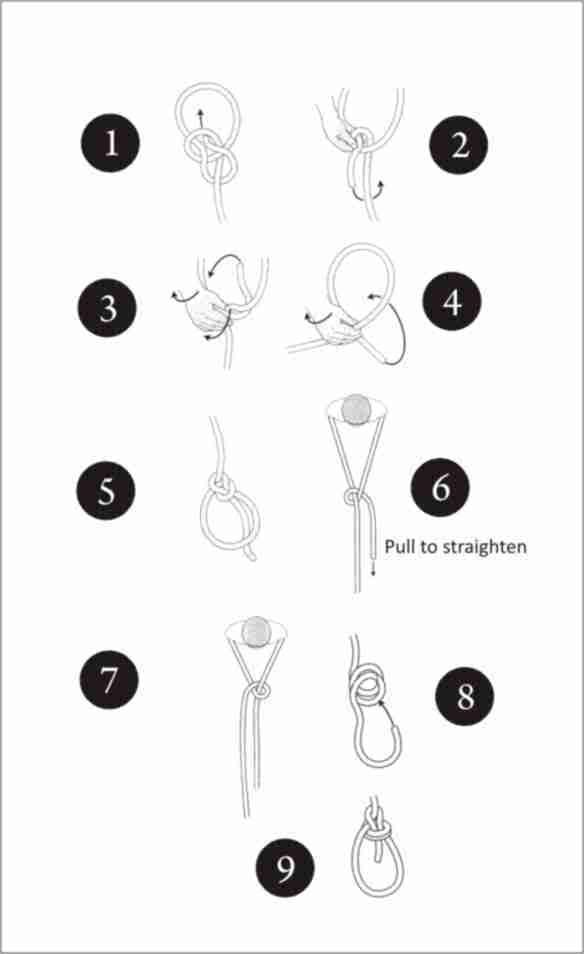Bowline
Applications : Neither a bend nor a hitch, the bowline (say 'boh-linn') is a knot that makes a fixed loop. It is far from the strongest loop knot, reducing the breaking strength of any stuff in which it is tied by as much as 40%. Nor is it very secure, particularly when the rope is stiff or slippery, when it has been known to capsize (if excessively loaded) or alternatively to spring or shake itself apart (when unloaded).Nevertheless the bowline can be used for a wide range of jobs, from securing the string before tying a parcel, to outdoor pursuits such as climbing. When I was a Metropolitan Police frogman in the 1960s, my colleagues and I tied the line around our waists with a simple bowline. The working end (deliberately made long) was then tucked several times around the adjacent part of the loop to secure it. Climbers' manuals advise their readers to finish off such tucks with one or two half-hitches (made in the opposite direction to the twist) for even greater
Methods : Make it by the so-called sailor's method with a fluent, one-handed twist of the wrist (1-5).You should also work out how to tie a bowline viewed from an unfamiliar angle (6-7). Imagine facing someone, passing a rope around behind them, beneath their armpits, then having to make the knot. See what I mean? The trick is to first take a turn around the standing part of the rope with your working end. Next, pull it out straight to transfer the underhand loop in the standing part. Finally, pass and tuck the working end to lock off in the usual way.If the knot will have to withstand rough treatment, tie the double bowline (8-9). This is therefore stronger and far more secure than a basic bowline

History : Stone Age en knew the sheet bend, which has an identical layout to the bowline, the only difference being which end is used where and for what. There is, however , no evidence of the bowline having been used that far back in the time. It was mentioned as a seafarer's knot by Sir Henry Mainwaring in The Sea-man's Dictionary (1644) and first illustrated in David Steel's Elemants and practice of Ringging and Seamanship in 1794. The time is long gone when it really was a 'bow line knot', used to hold the weather leech of a square sail forward closer to the wind, preventing it being pulled back. Other nautical uses include looping a boat's painter or ship's mooring rope around a quayside bollard, and tying a line around a crewman's waist, to lower him over the side. Two interlocked bowlines also form a handy hawser bend. Some useful variants on the common bowline (e.g., a double bowline, a bowline in the bight and a couple of triple bowlines ). All however, rely upon you first mastering the basic knot.
Applications : Neither a bend nor a hitch, the bowline (say 'boh-linn') is a knot that makes a fixed loop. It is far from the strongest loop knot, reducing the breaking strength of any stuff in which it is tied by as much as 40%. Nor is it very secure, particularly when the rope is stiff or slippery, when it has been known to capsize (if excessively loaded) or alternatively to spring or shake itself apart (when unloaded).Nevertheless the bowline can be used for a wide range of jobs, from securing the string before tying a parcel, to outdoor pursuits such as climbing. When I was a Metropolitan Police frogman in the 1960s, my colleagues and I tied the line around our waists with a simple bowline. The working end (deliberately made long) was then tucked several times around the adjacent part of the loop to secure it. Climbers' manuals advise their readers to finish off such tucks with one or two half-hitches (made in the opposite direction to the twist) for even greater
Methods : Make it by the so-called sailor's method with a fluent, one-handed twist of the wrist (1-5).You should also work out how to tie a bowline viewed from an unfamiliar angle (6-7). Imagine facing someone, passing a rope around behind them, beneath their armpits, then having to make the knot. See what I mean? The trick is to first take a turn around the standing part of the rope with your working end. Next, pull it out straight to transfer the underhand loop in the standing part. Finally, pass and tuck the working end to lock off in the usual way.If the knot will have to withstand rough treatment, tie the double bowline (8-9). This is therefore stronger and far more secure than a basic bowline

History : Stone Age en knew the sheet bend, which has an identical layout to the bowline, the only difference being which end is used where and for what. There is, however , no evidence of the bowline having been used that far back in the time. It was mentioned as a seafarer's knot by Sir Henry Mainwaring in The Sea-man's Dictionary (1644) and first illustrated in David Steel's Elemants and practice of Ringging and Seamanship in 1794. The time is long gone when it really was a 'bow line knot', used to hold the weather leech of a square sail forward closer to the wind, preventing it being pulled back. Other nautical uses include looping a boat's painter or ship's mooring rope around a quayside bollard, and tying a line around a crewman's waist, to lower him over the side. Two interlocked bowlines also form a handy hawser bend. Some useful variants on the common bowline (e.g., a double bowline, a bowline in the bight and a couple of triple bowlines ). All however, rely upon you first mastering the basic knot.


0 komentar:
Post a Comment